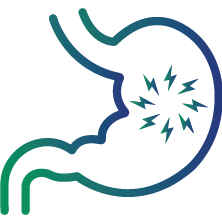
Iron & TIBC, Serum Test
Iron & TIBC, Serum Test
An iron serum test measures the level of iron in your blood. Iron is an essential micronutrient for the production of red blood cells (RBCs), which carry oxygen from the lungs to the rest of the body. Iron is also vital for healthy muscle, bone marrow, and organ function. Higher or lower iron levels can lead to serious health problems like cirrhosis (liver) and anaemia.
The total iron binding capacity (TIBC) test measures the total amount of iron that can be absorbed by transferrin proteins in the blood. Transferrin is an iron-binding protein. It helps in the transportation of iron and oxygen for the synthesis of haemoglobin. Healthcare providers use both Iron & TIBC tests to diagnose iron deficiency, anaemias, and other disorders of iron metabolism.
Iron is important for synthesis of haemoglobin (a protein in RBCs), and myoglobin synthesis (which carries and stores oxygen in muscle tissue). It also plays a vital role in the development of the brain and is essential for the normal production and functioning of hormones.
Iron & TIBC tests are performed during routine check-ups to detect anaemia caused by iron deficiency. These tests are used to monitor iron deficiency or overload in the body and to analyse the capacity of the blood to transport iron. Thus, early detection and treatment of iron deficiency or overload can prevent serious health conditions.
Symptoms of low iron levels

Pale skin

Fatigue

Dizziness

Shortness of breath

Rapid heartbeat
Symptoms of high iron levels

Joint pain

Stomach pain

Low energy

Weight loss
Which tests are included in the Iron & TIBC test?
The iron & TIBC test measures the level of iron and transferrin that are available to bind to iron in your blood
Serum iron test:
-
It measures the levels of iron present in the blood.
Total iron-binding capacity (TIBC):
-
It measures how well iron attaches to transferrin and other proteins in the blood. It is another way to measure how well the body transports iron
Who should get tested?
An iron & TIBC test is recommended for individuals shown to have anaemia or any problem with their red blood cells after a full blood count test. Doctors may also suggest an iron test if there are symptoms of too much iron in the body. Individuals should get tested for iron & TIBC in case of

Having low levels of iron (anaemia)

Having high levels of iron (Hemochromatosis) This is a rare genetic disorder that causes too much iron to build up in the body

Treatments for iron deficiency (low iron levels) or excess iron (high iron levels) are working or not
Test preparation:
Iron & TIBC tests may require fasting for up to 12 hours before the test; only drinking water during this time is recommended. Certain medicines may affect the results of this test. So, it is advised to talk to your doctor for details about pre-test preparations and make sure to follow instructions closely
Interpretation of results (micrograms per decilitre & in micromoles per litre)
|
Parameters |
Normal iron studies test values |
|
Iron |
60 to 170 mcg/dL (or) 10.74 to 30.43 micromol/L |
|
Total iron binding capacity (TIBC) |
240 to 450 mcg/dL (or) 42.96 to 80.55 micromol/L |
The above values are common measurements for the results of these tests. The normal reference ranges may vary among different laboratories. Talk to your healthcare provider to understand your specific test results.
Deviation from normal results indicates the following:
· Iron values below 60 mcg/dL may indicate low levels of iron in your blood.
· Iron values above 170 mcg/dL may indicate high levels of iron in your blood.
· TIBC value above 450 mcg/dL may indicate low levels of iron in your blood.
· TIBC value below 240 mcg/dL may indicate high levels of iron in your blood.
· Higher than normal iron level may be a sign of:
o Too much iron in the body (hemochromatosis)
o Anaemia due to red blood cells being destroyed quickly (Haemolytic anaemia)
o Liver tissue death
o Inflammation of the liver (hepatitis)
o Iron poisoning
· Lower than normal level may be a sign of:
o Long-term digestive tract bleeding
o Heavy menstrual bleeding
o Intestinal conditions causing poor absorption of iron
o Iron deficiency in the diet
o Types of anaemia
o Inherited blood disorder causing the body to make fewer RBCs (Thalassemia)
FAQs
What is the significance of the Iron & TIBC test?
The iron & TIBC test determines the level of iron and transferrin binding protein in your blood. The screening, monitoring, diagnosis, and follow-up of iron-deficiency anaemia as well as other diseases of iron metabolism can all be done with an iron & TIBC blood test
What are the risks associated with the Iron & TIBC test?
There are no known risks. During a blood test, one may experience minor pain or bruising where the needle was inserted, but most symptoms will subside quickly
How Iron & TIBC test is performed?
During this blood test, a healthcare professional will take a small amount of blood from a vein in your arm using a small needle, which is collected into a test tube or vial. This usually takes less than a few minutes
What is the turnaround time (TAT) for the results of an iron & TIBC test?
You will usually get the reports within 6 hours after the collection of the blood sample
When should I check my iron & TIBC levels during pregnancy?
Pregnant women are routinely checked for iron and TIBC levels during their initial prenatal appointment and again between 24 and 28 weeks of pregnancy

